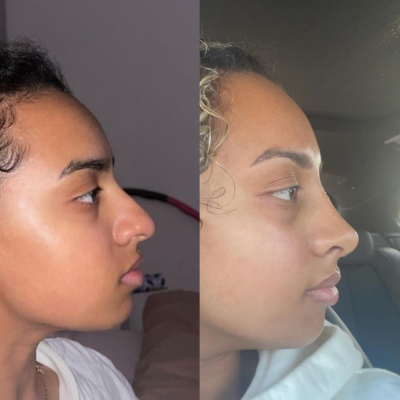Rhinoplasty, commonly known as a nose job, is a popular cosmetic surgery designed to enhance the appearance or function of the nose. There are two primary approaches to Rhinoplasty: open and closed. Deciding which technique is right for you depends on several factors including your aesthetic goals, the complexity of your case, and your surgeon’s recommendations.
What is Open Rhinoplasty?
Open Rhinoplasty is a technique where the surgeon makes a small incision on the columella - the soft tissue between the nostrils. This allows the surgeon to lift the nasal skin, providing greater visibility and access to the underlying nasal structures. Open Rhinoplasty is often recommended for more complex cases where significant reshaping of the nose is required, such as correcting severe asymmetry, performing revisions, or addressing nasal deformities.
Speaking about the procedure, ENT and Facial Plastic Surgeon, Professor Raghavan said: “The surgery typically takes between two to three hours, depending on the complexity of the changes being made. Once the incisions are made, the surgeon can modify the nasal bone, cartilage, and soft tissues to achieve the desired shape. Afterward, the incisions are carefully sutured, and a splint is placed on the nose to protect it during the healing process. The recovery time for Open Rhinoplasty is generally longer than for Closed Rhinoplasty, with swelling and bruising lasting for several weeks. However, the results are often more precise for patients requiring extensive corrections. While scarring is a potential concern, the incision on the columella is small and typically heals well, becoming almost invisible over time.”
What is Closed Rhinoplasty?
Closed Rhinoplasty, also known as Endonasal Rhinoplasty, is performed entirely within the nostrils, with no external incisions. This technique is less invasive, making it ideal for patients who require minor adjustments to the nose, such as refining the nasal tip or removing a hump. Because the skin is not lifted, the surgeon’s visibility of the nasal structures is more limited compared to Open Rhinoplasty.
Professor Raghavan continued: “The procedure generally takes less time than Open Rhinoplasty, lasting around one to two hours. The surgeon works through small incisions inside the nostrils, allowing them to make adjustments to the nasal cartilage and bone. Since there are no external cuts, scarring is not a concern, and the recovery time is typically shorter.
“Patients undergoing Closed Rhinoplasty usually experience less swelling and bruising, and the overall healing process is quicker. However, because the surgeon has less direct visibility, this approach may not be suitable for more complex cases that require extensive reshaping.”
Pros and cons of Open vs Closed Rhinoplasty
Choosing between Open and Closed Rhinoplasty depends on the specifics of your case and your desired outcomes. Below is a breakdown of the advantages and disadvantages of each approach.
Pros and cons of Open Rhinoplasty
Pros:
Greater visibility for the surgeon, allowing for more precise corrections, especially in complex cases
Easier access to the nasal framework, which is helpful for addressing significant asymmetries, deformities, or performing revisions
More control over reshaping the nose, particularly the nasal tip
Cons:
Longer recovery time due to more extensive surgery
Potential for a small, though typically minimal, scar on the columella
Increased swelling and bruising compared to Closed Rhinoplasty
Pros and cons of Closed Rhinoplasty
Pros:
No visible external scars, as the incisions are made inside the nostrils
Faster recovery time, with less swelling and bruising
Shorter procedure duration compared to Open Rhinoplasty
Cons:
Limited visibility for the surgeon, which can make complex cases more challenging
May not be suitable for significant nasal reshaping or revisions
Less precision in certain areas, particularly when addressing the nasal tip
See how Rhinoplasty has helped our patients
At Pall Mall, our patients have experienced life-changing results from both Open and closed Rhinoplasty procedures. From subtle refinements to major reshaping, our expert surgeons work closely with each patient to ensure their expectations are met.
One notable success story is Gabriella Bardsley, who underwent a Septorhinoplasty procedure. This surgery not only addressed her breathing issues but also improved the overall symmetry and appearance of her nose. Gabriella’s journey exemplifies how Rhinoplasty can achieve both functional and aesthetic goals, offering a comprehensive solution to nasal concerns.
If you’re considering Rhinoplasty and want to know which surgery is right for you, our expert team at Pall Mall is here to help. We offer both Open and Closed Rhinoplasty, as well as Septorhinoplasty for functional corrections. Book a free, no obligation consultation to discuss your cosmetic surgery goals.





